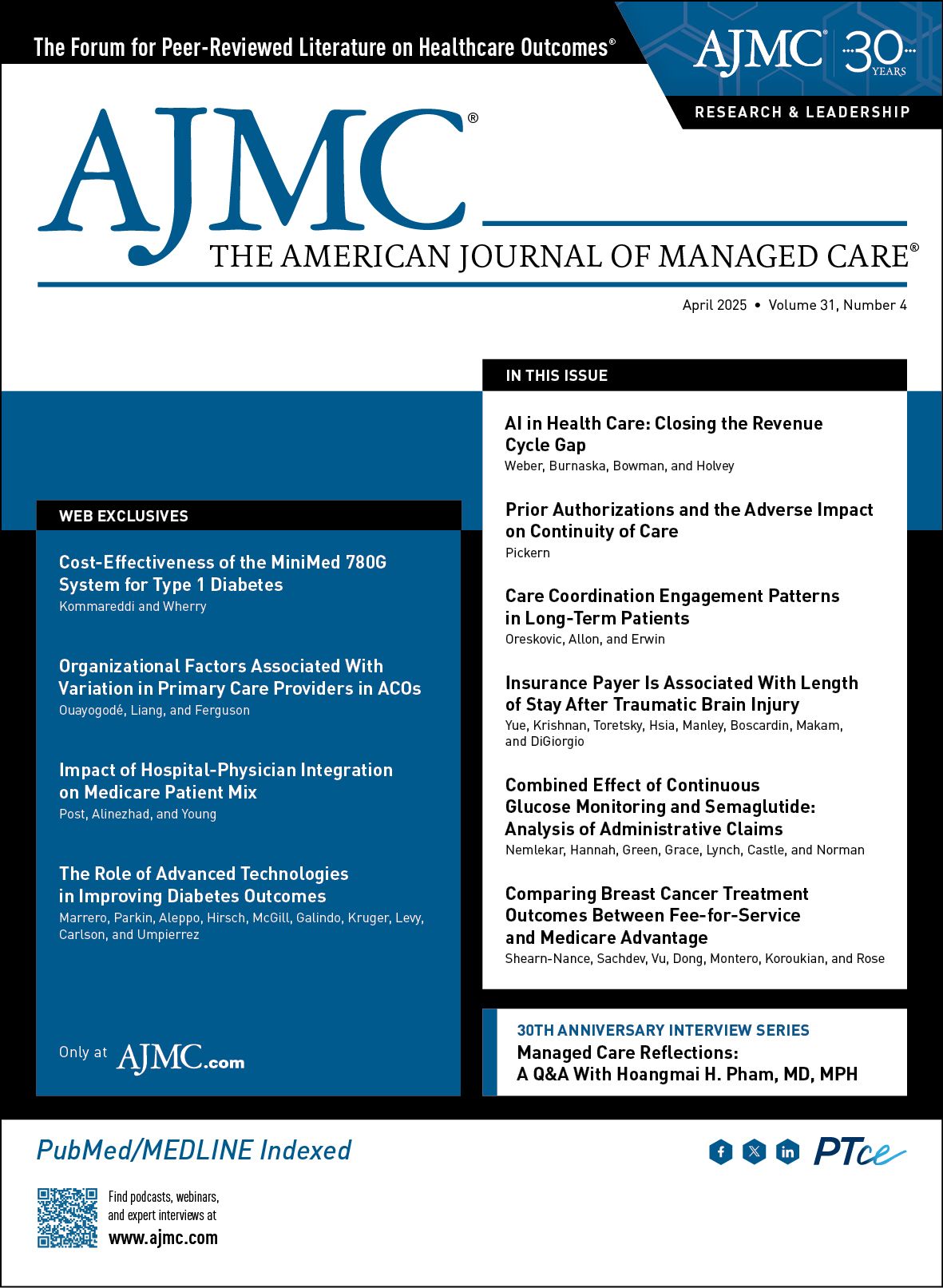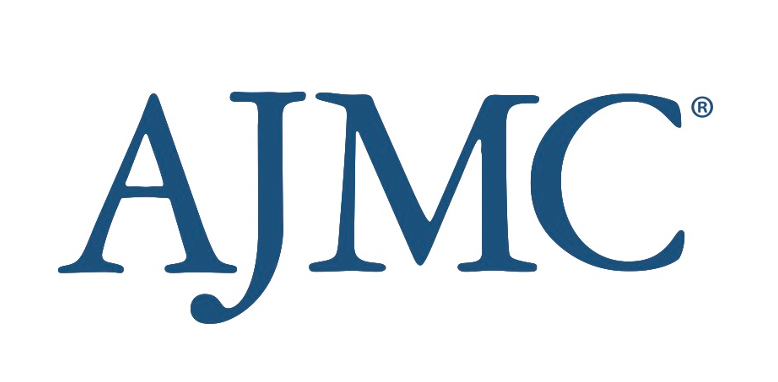Publication
Article
The American Journal of Managed Care
Comparing Breast Cancer Treatment Outcomes Between Fee-for-Service and Medicare Advantage
Author(s):
This study examined postdiagnosis breast cancer treatment outcomes for Medicare Advantage vs fee-for-service (FFS) Medicare in Ohio and found no significant differences overall but disparities for Black patients with FFS Medicare.
ABSTRACT
Objectives: Medicare Advantage (MA) enrollment has increased over the past 2 decades. We compare receipt of standard treatment, time to treatment initiation (TTI), and overall survival (OS) between fee-for-service (FFS) Medicare and MA for women in Ohio with breast cancer.
Study Design: Retrospective cohort.
Methods: We used Ohio cancer registry data linked with Medicare enrollment files to identify women diagnosed between 2011 and 2016 with local- or regional-stage breast cancer. We evaluated the association between FFS or MA and each outcome, adjusting for age, race, marital status, county type, neighborhood poverty level, stage, hormone receptor status, and dual Medicare-Medicaid enrollment. Standard treatment was mastectomy or breast-conserving surgery plus radiotherapy; chemotherapy for regional disease; and hormone therapy if hormone receptor positive.
Results: A total of 12,349 patients met inclusion criteria (6801 FFS; 5548 MA). No difference was found in receipt of standard treatment between FFS and MA patients (adjusted OR [AOR], 0.99; 95% CI, 0.91-1.08) or between Black and White patients (AOR, 1.14; 95% CI, 0.94-1.40); however, Black patients with FFS had lower odds of standard treatment (AOR for interaction, 0.75; 95% CI, 0.57-0.99). We detected no difference in TTI (adjusted HR [AHR], 0.98; 95% CI, 0.94-1.01) or OS (AHR, 1.03; 95% CI, 0.92-1.15) between FFS and MA patients, and we found no significant interaction between MA status and race for OS or TTI.
Conclusions: MA enrollment was not independently associated with standard treatment, TTI, or OS after cancer diagnosis. Further work is needed to understand why Black patients with FFS Medicare were less likely to receive standard treatment.
Am J Manag Care. 2025;31(4):190-196. https://doi.org/10.37765/ajmc.2025.89720
Takeaway Points
This study compares postdiagnosis breast cancer treatment outcomes between Medicare Advantage (MA) and fee-for-service (FFS) Medicare in Ohio, finding no significant differences overall but disparities for Black patients.
- No significant differences overall were seen in odds of receiving standard treatment, time to treatment initiation, and overall survival between MA and FFS plans for patients with breast cancer.
- Black patients with FFS coverage were less likely to receive standard treatment than others.
For the first time, a majority of Medicare-eligible patients in the US are insured by Medicare Advantage (MA) insurance plans as opposed to fee-for-service (FFS) Medicare.1 Although only 19% of Medicare beneficiaries were enrolled in MA plans in 2007, by January 2023, CMS reported that slightly more than 50% of all beneficiaries were covered by MA, marking a milestone in the way older adults are insured in the US.2
MA plans, which have historically been referred to as Medicare managed care, encompass a broad group of health insurance plans for older individuals and those with disabilities, and they differ in a number of ways from traditional FFS Medicare.3 In contrast to FFS Medicare, MA plans are privately administered insurance products that offer enrollees greater limitations on out-of-pocket spending and often include extra benefits such as dental, hearing, and vision coverage. These plans are financed through fixed payments from CMS to the insurers, often supplemented by premium contributions from enrollees. MA plans may integrate prescription drug coverage, require enrollees to use specific provider networks, implement utilization management techniques, or feature tools for care management including prior authorization requirements and reward programs for healthy behaviors.3-5
The original rationale behind including private plans in Medicare was to reap the purported efficiencies of the private insurance market and to allow Medicare beneficiaries to utilize existing health maintenance organization infrastructure.4,5 Theoretically, MA plans may encourage more efficient and proactive management of health services by giving private insurers a financial incentive to cut costs while achieving specific quality benchmarks.3-5 However, despite the intent of policy makers, overall spending is higher for MA enrollees than for traditional Medicare enrollees.4,6 Beneficiaries in MA report choosing their plan based on added benefits and reduced out-of-pocket expenses, whereas those opting for traditional Medicare typically prioritize a broader selection of providers.7 Studies have shown varied effects of MA enrollment on patient outcomes, although the data are limited and likely confounded by residual favorable selection of healthier patients into MA plans.8-13
The proportion of Medicare enrollees selecting MA plans is expected to rise to nearly 70% by 2030.14 As such, it is increasingly important to compare processes of care and outcomes between patients on FFS and MA. In this study, we focus on the receipt of stage-appropriate standard treatment and time to treatment initiation (TTI) among women with breast cancer, the most common nonskin cancer and second deadliest cancer in women in the US.15 Because appropriate and timely treatment in breast cancer impacts outcomes, factors affecting quality of care for these women are particularly relevant—especially given the substantial disparities in breast cancer outcomes documented along dimensions of race, income, and education.16,17
In this study, we investigated differences in treatment and outcomes between women with breast cancer enrolled in MA and FFS in Ohio from 2011 to 2016. Using Medicare claims data linked with state cancer registry records, we examined receipt of standard treatment, TTI, and overall survival (OS) as well as whether relationships between plan type and outcomes after diagnosis differed across demographic subgroups.
METHODS
Data Sources
We utilized the Ohio Cancer Incidence Surveillance System (OCISS) linked with Medicare enrollment and claims data from January 1, 2011, to December 31, 2016, as previously described.18 OCISS, Ohio’s central cancer registry, captures all cases of incident cancer in Ohio as well as a variety of demographic variables (eg, sex, age, race, residence), disease-related factors (eg, primary cancer site, date of diagnosis, stage at diagnosis, and dates and modalities of first-line treatment), and survival status. The linked Medicare data contain the Medicare Beneficiary Summary File, which includes demographic information, and monthly indicators for parts A, B, C (ie, MA), and D enrollment.
Study Population
The study included all women diagnosed with local- or regional-stage breast cancer from 2011 to 2016 who were 65 years or older at the time of cancer diagnosis, as reported from the OCISS.
Variables of Interest
Our outcomes of interest were receipt of standard treatment, TTI, and OS. For all patients, receipt of standard treatment was defined as either mastectomy or the combination of lumpectomy and radiation.18 Additionally, chemotherapy was required for patients with regional-stage disease and hormonal therapy was required for patients with hormone receptor–positive disease.18 The outcome of TTI, which has been associated with mortality, was defined as time from the date of diagnosis to the date of initiation of any treatment modality.18,19 OS was defined as time from diagnosis to the individual’s death or the end of study, whichever came first.18
Our main independent variable was Medicare type, distinguished as being either FFS or MA during the month of cancer diagnosis. Other independent variables included age at diagnosis, categorized as a continuous variable; stage at diagnosis; race, grouped as White, Black, and other; marital status, grouped as married and all other (encompassing single never married, married and then widowed, divorced, and unknown); county type, identified as either metropolitan and non-Appalachian, nonmetropolitan and non-Appalachian, or Appalachian; census tract poverty level; and patient dual eligibility for Medicare and Medicaid.
Statistical Analysis
Multivariable logistic regression was performed to examine the relationship of Medicare type with receipt of standard treatment, and Cox proportional hazards regression was performed to examine the association of Medicare type with TTI and OS. We controlled for all variables in our models as described earlier. Additionally, we used interaction terms to explore the association between race and the receipt of standard treatment, TTI, and OS. All analyses were conducted in SAS 9.4 (SAS Institute Inc) and R 4.1.1 (R Foundation for Statistical Computing).
The linkage of the OCISS and Medicare data was performed by CMS. CMS and the Ohio Department of Health approved our use of Medicare and OCISS data through their respective data use agreements. This study was approved by the Case Western Reserve University and Ohio Department of Health institutional review boards.
RESULTS
We identified 12,349 women diagnosed with local- or regional-stage breast cancer in Ohio and enrolled in Medicare from 2011 to 2016. Of these, 6801 (55.1%) patients were enrolled in FFS Medicare and 5548 (44.9%) were enrolled in an MA plan at the month of diagnosis.
Table 1 shows patient characteristics stratified by Medicare type. Fifty-five percent of patients were aged 66 to 74 years, 34% were aged 75 to 84 years, and the remaining 11% were 85 years or older. This distribution was comparable between MA and FFS enrollees. The percentage of patients residing in metropolitan counties was higher among MA enrollees than their FFS counterparts (75.7% vs 70.1%), and the percentage of those residing in nonmetropolitan/non-Appalachian counties was lower in MA enrollees. In addition, the percentage of women with dual Medicare/Medicaid eligibility status was slightly higher in the FFS group than in MA enrollees (10.9% vs 8.3%). The distributions of stage, hormone receptor status, and treatment modalities (ie, surgery, radiation, and hormonal therapy) were similar between FFS and MA enrollees.
Stratification by receipt of standard treatment reveals a similar picture to stratification by coverage type, with a few notable differences (Table 2). More than one-third of patients not receiving standard treatment had regional disease spread compared with 13.2% of patients who received standard treatment. Those 85 years or older also made up a greater percentage of the patients not receiving standard treatment (17.8%) than of patients receiving standard treatment (3.7%). Marital status also differed slightly between groups receiving standard and nonstandard treatment.
We used multivariable logistic regression to assess to what extent a patient’s Medicare type, demographic factors, cancer stage, and area-level characteristics were associated with receipt of standard treatment (Figure 1). Additionally, logistic regression with interaction terms was used to elucidate the impact of race on receipt of standard treatment. FFS Medicare patients had similar odds of receiving standard treatment compared with patients on MA plans (adjusted OR [AOR], 0.99; 95% CI, 0.91-1.08). No difference was found in receipt of standard treatment between Black and White patients (AOR, 1.14; 95% CI, 0.94-1.40). Additionally, increased age at diagnosis was associated with lower odds of receiving standard treatment (AOR, 0.90; 95% CI, 0.89-0.90). Dually eligible patients also had lower odds of receiving standard treatment (AOR, 0.76; 95% CI, 0.66-0.87), as did patients with regional tumor spread (vs a localized tumor) (AOR, 0.24; 95% CI, 0.22-0.26). The interaction term suggests that women who are Black and in an FFS plan were less likely to receive standard treatment than their counterparts in MA (AOR for interaction, 0.75; 95% CI, 0.57-0.99).
Results from the Cox model suggest no statistically significant difference in TTI between patients covered by Medicare FFS and MA (adjusted HR [AHR], 0.98; 95% CI, 0.94-1.01) (Figure 2). Compared with their married counterparts, nonmarried women had an increased TTI (AHR, 0.92; 95% CI, 0.89-0.96). Black patients had increased TTI (AHR, 0.78; 95% CI, 0.72-0.86) compared with White patients, and dual eligibility was associated with an increased TTI (AHR, 0.84; 95% CI, 0.79-0.90). Relative to localized disease, patients with regional spread had a slight increase in TTI (AHR, 0.95; 95% CI, 0.91-0.99).
We found no statistically significant difference in OS between patients covered by Medicare FFS and MA (AHR, 1.03; 95% CI, 0.92-1.15) (Figure 3). Receipt of standard treatment was independently associated with improved OS (AHR, 0.64; 95% CI, 0.56-0.72). Increasing age at diagnosis was associated with unfavorable survival outcomes (AHR, 1.08; 95% CI, 1.07-1.09), and not being married was associated with worse survival outcomes (AHR, 1.34; 95% CI, 1.18-1.52). Dual eligibility was associated with substantially decreased OS (AHR, 2.09; 95% CI, 1.82-2.40). Lastly, patients with regional spread showed a large decrease in OS (AHR, 1.78; 95% CI, 1.59-1.99) compared with patients with localized disease. We did not find any significant interaction between MA status and race for OS or TTI.
DISCUSSION
Nationwide, MA penetration has doubled over the last decade, with more than half of the eligible Medicare population enrolled in an MA plan in 2023.2 Therefore, comparing cancer treatment and outcomes between patients in traditional FFS and MA plans takes on renewed import.1
The primary finding in this study was a lack of difference in receipt of standard treatment, TTI, and OS between FFS and MA patients after diagnosis with breast cancer. However, we found that Black patients with FFS coverage were less likely to receive standard treatment than Black patients in MA plans, as suggested by the interaction term in the regression model. Secondarily, we identified treatment delays for Black patients and for patients who had dual eligibility for Medicare and Medicaid. These dually eligible patients also had more than a 2-fold decrease in OS and lower odds of receiving standard treatment. We also found that patients with regional disease spread had much lower odds of receiving standard treatment compared with patients with local spread and had slightly increased TTI.
Prior studies comparing FFS and MA have shown mixed results, depending on the specific population or intervention in question. In a review of the literature, we did not find any studies in which mortality was a primary outcome of comparison between patients with cancer in MA and FFS plans. Three studies compared mortality between MA and traditional FFS Medicare, but none focused on patients with cancer.20-22 One study, using data from 2009, examined inpatient mortality for acute myocardial infarction, stroke, pneumonia, and congestive heart failure for patients in MA and FFS and identified no difference in mortality at all between the 2 groups, although this study looked specifically at inpatient mortality irrespective of condition rather than OS.21 Another study found that MA participants had slightly lower mortality in a 1-year time frame than would have been expected for individuals with a similar risk profile enrolled in FFS Medicare.22 Lastly, a 2019 study reported that individuals who select MA have lower rates of mortality than individuals with FFS, but the difference gets smaller as time goes on.20 This is an overall mixed picture, although again we emphasize that none of these studies looked specifically at patients with breast cancer, who might be expected to have different mortality rates than the general Medicare population.
To our knowledge, no previous studies have compared receipt of standard treatment and TTI between patients with cancer in MA and FFS plans. A 2021 systematic review discussed 9 studies that compared other quality-of-care metrics between MA and FFS plans, with very mixed results.11 Perhaps most relevant to our study, another 2021 study found that, controlling for distance to the hospital, MA enrollees were less likely to use top-ranked cancer hospitals for complex cancer surgery than FFS enrollees.23 However, this study did not consider usage outside of top-ranked hospitals, so although some studies do show superior outcomes for cancer surgeries at top-ranked hospitals, this represents a poor proxy outcome at best.24,25 Lastly, biases against publishing negative results may contribute to the slight skew in favor of MA in quality markers.26,27
We feel that the parity of care we observed between MA and FFS coverage is an encouraging outcome, as it suggests that patients with breast cancer may expect to receive comparable care and have similar health outcomes following their diagnosis regardless of which Medicare plan type they enroll in. However, we did find evidence that among Black women, those in FFS were less likely to receive standard treatment than those in MA plans. There are several possible explanations for these findings. Historically, MA plans have faced accusations of cherry-picking, or favorable selection of lower-risk patients. Some evidence also suggests racial disparities in access to high-quality MA plans.28 Over the years, policy changes appear to have markedly reduced these disparities but have not completely eliminated them.8,29,30 Additionally, research suggests that Black patients in FFS plans are less likely to have supplemental Medigap plans, which may impact access to care and therefore treatment outcomes.31 Another possible explanation for these findings is suggested by published work that found Black patients in FFS plans receiving coronary artery bypass grafting were less likely than their White counterparts to receive care from high-quality hospitals, even when those hospitals were geographically close to them.32 These findings warrant further research involving subgroup analysis—such as among specific demographic and socioeconomic subpopulations—which may reveal other such inequities between FFS and MA groups.
As noted previously, we found that the deviation from receipt of standard treatment increased with age at diagnosis. One possible explanation for this is a nuance of clinical practice: Radiation therapy is frequently omitted in the treatment of patients older than 70 years with estrogen receptor–positive stage I breast cancer. A 2004 randomized trial showed that for women 70 years or older with estrogen receptor–positive stage I breast cancer, addition of radiation therapy conferred no survival benefit beyond lumpectomy and adjuvant endocrine therapy, and subsequent follow-up studies have confirmed these results.33-35 Consequently, many oncologists elect to omit radiation therapy in this patient population.36
Regarding the observed decreased odds of receiving standard treatment in patients with regional spread, our definition of standard therapy includes the requirement for chemotherapy in these patients. This additional parameter increases the probability that patients with regional spread might not receive standard therapy. Second, regional spread at time of diagnosis may serve as a proxy for poor access to care. We observed a slight increase in TTI for these patients, which supports that this may be a confounder.
Limitations and Strengths
Our study has several limitations. First, we focused on patients from Ohio only, and our results may not be generalizable to patients in other states. Second, we compared outcomes only for patients with breast cancer, so these results may not be generalizable to treatment outcomes for patients with other cancers. Third, we had limited data regarding HER2 status and receipt of HER2-targeted therapies, which is important to those with this subtype of breast cancer. We were also not able to identify individuals who declined standard treatment or were deemed medically ineligible to undergo standard treatment, which may have impacted our results.
Strengths of this study include the comprehensive and robust nature of the OCISS database, which allowed us to obtain detailed demographic data not otherwise obtainable through Medicare claims data. Indicators from the Medicare data enabled the identification of individuals who received care through traditional FFS Medicare, whereas the OCISS enabled us to extrapolate about MA outcomes. This allowed us to compare treatment outcomes between FFS and MA patients, which cannot be done with Medicare claims and enrollment data alone. Another strength of this study is our large patient population, encompassing more than 12,000 individuals in the state of Ohio.
This study raises several questions for follow-up. Of particular note, the subgroup interaction between race and insurance type, as noted earlier in the discussion, warrants further study. Additionally, an analysis that compares outcomes between the many different available MA plans could offer additional nuance to the scientific conversation.
CONCLUSIONS
In this study, we found that MA plans were not associated with any difference in the odds of receiving standard treatment, TTI, or OS for patients post breast cancer diagnosis compared with traditional FFS Medicare plans. These results are encouraging, suggesting a parity of care between MA and FFS plans for most patients. However, we did identify that although there was no significant effect of Medicare type across the population, Black patients with FFS coverage were less likely to receive standard treatment than Black patients with MA plans, raising worrying questions about equity within racial groups.
Author Affiliations: Department of Population and Quantitative Health Sciences (LV, WD, SMK) and Center for Community Health Integration (JR), School of Medicine, Case Western Reserve University (GS-N, RRS), Cleveland, OH; Case Comprehensive Cancer Center (LV, WD, SMK, JR), Cleveland, OH; Division of Medical Oncology, University Hospitals Seidman Cancer Center (AJM), Cleveland, OH.
Source of Funding: This research was funded by a grant from the National Cancer Institute to Case Comprehensive Cancer Center (#P30CA043703 to Drs Rose and Koroukian).
Author Disclosures: Dr Montero reports receiving fees for serving as medical director for Paragon Infusion Services and honoraria from AstraZeneca and Gilead Sciences. Dr Koroukian reports receiving travel reimbursement for a presentation at the 2022 annual meeting of the American Association for Cancer Research. The remaining authors report no relationship or financial interest with any entity that would pose a conflict of interest with the subject matter of this article.
Authorship Information: Concept and design (GS-N, RRS, LV, SMK, JR); acquisition of data (SMK); analysis and interpretation of data (GS-N, RRS, LV, WD, AJM, SMK, JR); drafting of the manuscript (GS-N, RRS, LV, AJM, SMK, JR); critical revision of the manuscript for important intellectual content (GS-N, LV, WD, AJM, SMK, JR); statistical analysis (GS-N, LV); obtaining funding (SMK); administrative, technical, or logistic support (WD, SMK); and supervision (JR).
Address Correspondence to: Johnie Rose, MD, PhD, Case Western Reserve University, 11000 Euclid Ave, Ste 402, Cleveland, OH 44106-7136. Email: johnie.rose@case.edu.
REFERENCES
1. Biniek JF, Freed M, Damico A, Neuman T. Half of all eligible Medicare beneficiaries are now enrolled in private Medicare Advantage plans. KFF. May 1, 2023. Accessed May 7, 2023. https://www.kff.org/policy-watch/half-of-all-eligible-medicare-beneficiaries-are-now-enrolled-in-private-medicare-advantage-plans/
2. Ochieng N, Biniek JF, Freed M, Damico A, Neuman T. Medicare Advantage in 2023: enrollment update and key trends. KFF. August 9, 2023. Accessed January 7, 2024. https://web.archive.org/web/20240107111334/https://www.kff.org/medicare/issue-brief/medicare-advantage-in-2023-enrollment-update-and-key-trends/
3. McGuire TG, Newhouse JP, Sinaiko AD. An economic history of Medicare Part C. Milbank Q. 2011;89(2):289-332. doi:10.1111/j.1468-0009.2011.00629.x
4. Jacobson G, Blumenthal D. The predominance of Medicare Advantage. N Engl J Med. 2023;389(24):2291-2298. doi:10.1056/NEJMhpr2302315
5. Neuman P, Jacobson GA. Medicare Advantage checkup. N Engl J Med. 2018;379(22):2163-2172. doi:10.1056/NEJMhpr1804089
6. Ochieng N, Biniek JF. Beneficiary experience, affordability, utilization, and quality in Medicare Advantage and traditional Medicare: a review of the literature. KFF. September 16, 2022. Accessed January 4, 2024. https://www.kff.org/report-section/beneficiary-experience-affordability-utilization-and-quality-in-medicare-advantage-and-traditional-medicare-a-review-of-the-literature-report/
7. Leonard F, Jacobson G, Haynes LA, Collins SR. Traditional Medicare or Medicare Advantage: how older Americans choose and why. The Commonwealth Fund. October 17, 2022. Accessed January 5, 2024. https://bit.ly/4iF6hNp
8. Newhouse JP, Price M, McWilliams JM, Hsu J, McGuire TG. How much favorable selection is left in Medicare Advantage? Am J Health Econ. 2015;1(1):1-26. doi:10.1162/ajhe_a_00001
9. Landon BE, Zaslavsky AM, Bernard SL, Cioffi MJ, Cleary PD. Comparison of performance of traditional Medicare vs Medicare managed care. JAMA. 2004;291(14):1744-1752. doi:10.1001/jama.291.14.1744
10. Aggarwal R, Gondi S, Wadhera RK. Comparison of Medicare Advantage vs traditional Medicare for health care access, affordability, and use of preventive services among adults with low income. JAMA Netw Open. 2022;5(6):e2215227. doi:10.1001/jamanetworkopen.2022.15227
11. Agarwal R, Connolly J, Gupta S, Navathe AS. Comparing Medicare Advantage and traditional Medicare: a systematic review. Health Aff (Millwood). 2021;40(6):937-944. doi:10.1377/hlthaff.2020.02149
12. Timbie JW, Bogart A, Damberg CL, et al. Medicare Advantage and fee-for-service performance on clinical quality and patient experience measures: comparisons from three large states. Health Serv Res. 2017;52(6):2038-2060. doi:10.1111/1475-6773.12787
13. Jayasekara H, MacInnis RJ, Chamberlain JA, et al. Mortality after breast cancer as a function of time since diagnosis by estrogen receptor status and age at diagnosis. Int J Cancer. 2019;145(12):3207-3217. doi:10.1002/ijc.32214
14. McWilliams JM. Don’t look up? Medicare Advantage’s trajectory and the future of Medicare. Health Affairs Forefront. March 24, 2022. Accessed January 4, 2024. https://www.healthaffairs.org/content/forefront/don-t-look-up-medicare-advantage-s-trajectory-and-future-medicare
15. Siegel RL, Miller KD, Wagle NS, Jemal A. Cancer statistics, 2023. CA Cancer J Clin. 2023;73(1):17-48. doi:10.3322/caac.21763
16. Brawley OW, Lansey DG. Disparities in breast cancer outcomes and how to resolve them. Hematol Oncol Clin North Am. 2023;37(1):1-15. doi:10.1016/j.hoc.2022.08.002
17. Carey LA, Perou CM, Livasy CA, et al. Race, breast cancer subtypes, and survival in the Carolina Breast Cancer Study. JAMA. 2006;295(21):2492-2502. doi:10.1001/jama.295.21.2492
18. Koroukian SM, Dong W, Albert JM, et al. Treatment patterns and survival outcomes in breast cancer patients on Medicaid, pre- and post-expansion. J Natl Compr Canc Netw. 2024;22(3):e237104. doi:10.6004/jnccn.2023.7104
19. Cone EB, Marchese M, Paciotti M, et al. Assessment of time-to-treatment initiation and survival in a cohort of patients with common cancers. JAMA Netw Open. 2020;3(12):e2030072. doi:10.1001/jamanetworkopen.2020.30072
20. Newhouse JP, Price M, McWilliams JM, Hsu J, Souza J, Landon BE. Adjusted mortality rates are lower for Medicare Advantage than traditional Medicare, but the rates converge over time. Health Aff (Millwood). 2019;38(4):554-560. doi:10.1377/hlthaff.2018.05390
21. Hines AL, Raetzman SO, Barrett ML, Moy E, Andrews RM. Managed care and inpatient mortality in adults: effect of primary payer. BMC Health Serv Res. 2017;17(1):121. doi:10.1186/s12913-017-2062-1
22. Beveridge RA, Mendes SM, Caplan A, et al. Mortality differences between traditional Medicare and Medicare Advantage: a risk-adjusted assessment using claims data. Inquiry. 2017;54:46958017709103. doi:10.1177/0046958017709103
23. Kim D, Meyers DJ, Rahman M, Trivedi AN. Comparison of the use of top-ranked cancer hospitals between Medicare Advantage and traditional Medicare. Am J Manag Care. 2021;27(10):e355-e360. doi:10.37765/ajmc.2021.88766
24. Tay E, Gambhir S, Stopenski S, et al. Outcomes of complex gastrointestinal cancer resection at US News & World Report top-ranked vs non-ranked hospitals. J Am Coll Surg. 2021;233(1):21-27.e1. doi:10.1016/j.jamcollsurg.2021.02.012
25. Boffa DJ, Mallin K, Herrin J, et al. Survival after cancer treatment at top-ranked US cancer hospitals vs affiliates of top-ranked cancer hospitals. JAMA Netw Open. 2020;3(5):e203942. doi:10.1001/jamanetworkopen.2020.3942
26. Ayorinde AA, Williams I, Mannion R, et al. Publication and related biases in health services research: a systematic review of empirical evidence. BMC Med Res Methodol. 2020;20(1):137. doi:10.1186/s12874-020-01010-1
27. Dowdy A, Hantula DA, Travers JC, Tincani M. Meta-analytic methods to detect publication bias in behavior science research. Perspect Behav Sci. 2021;45(1):37-52. doi:10.1007/s40614-021-00303-0
28. Park S, Werner RM, Coe NB. Racial and ethnic disparities in access to and enrollment in high-quality Medicare Advantage plans. Health Serv Res. 2023;58(2):303-313. doi:10.1111/1475-6773.13977
29. She Z, Ayer T, Montanera D. Can big data cure risk selection in healthcare capitation program? a game theoretical analysis. Manuf Serv Oper Manag. 2022;24(6):3117-3134. doi:10.1287/msom.2022.1127
30. Ryan AM, Chopra Z, Meyers DJ, Fuse Brown EC, Murray RC, Williams TC. Favorable selection in Medicare Advantage is linked to inflated benchmarks and billions in overpayments to plans. Health Aff (Millwood). 2023;42(9):1190-1197. doi:10.1377/hlthaff.2022.01525
31. Park S, Meyers DJ, Rivera-Hernandez M. Enrollment in supplemental insurance coverage among Medicare beneficiaries by race/ethnicity. J Racial Ethn Health Disparities. 2022;9(5):2001-2010. doi:10.1007/s40615-021-01138-w
32. Popescu I, Huckfeldt P, Pane JD, Escarce JJ. Contributions of geography and nongeographic factors to the White-Black gap in hospital quality for coronary heart disease: a decomposition analysis. J Am Heart Assoc. 2019;8(23):e011964. doi:10.1161/JAHA.119.011964
33. Hughes KS, Schnaper LA, Berry D, et al; Cancer and Leukemia Group B; Radiation Therapy Oncology Group; Eastern Cooperative Oncology Group. Lumpectomy plus tamoxifen with or without irradiation in women 70 years of age or older with early breast cancer. N Engl J Med. 2004;351(10):971-977. doi:10.1056/NEJMoa040587
34. Hughes KS, Schnaper LA, Bellon JR, et al. Lumpectomy plus tamoxifen with or without irradiation in women age 70 years or older with early breast cancer: long-term follow-up of CALGB 9343. J Clin Oncol. 2013;31(19):2382-2387. doi:10.1200/JCO.2012.45.2615
35. Whelan TJ, Smith S, Nielsen TO, et al. LUMINA: a prospective trial omitting radiotherapy (RT) following breast conserving surgery (BCS) in T1N0 luminal A breast cancer (BC). J Clin Oncol. 2022;40(suppl 17):LBA501. doi:10.1200/JCO.2022.40.17_suppl.LBA501
36. Shumway DA, Griffith KA, Sabel MS, et al. Surgeon and radiation oncologist views on omission of adjuvant radiotherapy for older women with early-stage breast cancer. Ann Surg Oncol. 2017;24(12):3518-3526. doi:10.1245/s10434-017-6013-1







